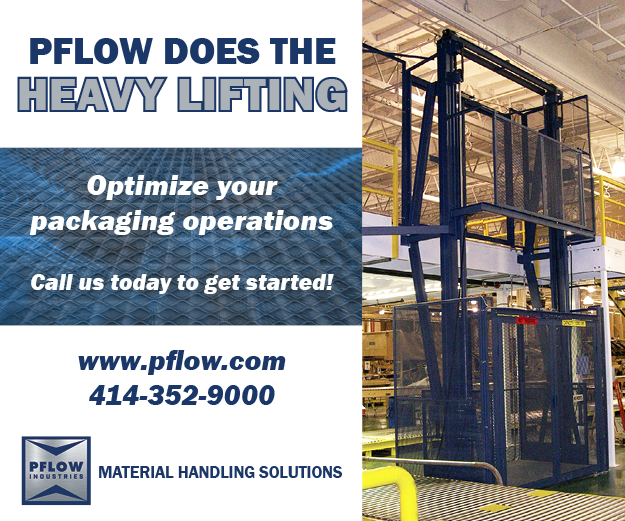The Need for Speed in the Age Of eCommerce
By Derek Rickard, Contributor

Automated warehouses can run 24/7—at optimal speeds—and alleviate warehouse workers from the physically demanding tasks involved in product picking. (photo courtesy Cimcorp)
When Amazon burst onto the scene around 25 years ago, few could envision how the then-novel idea of online shopping would radically transform consumer habits and expectations. Today, eCommerce continues to thrive on the convenience it offers to consumers, who now enjoy a virtually limitless number of product choices. From clothing to groceries, they can now order anything they want and need—and have it delivered right to their door in 24-48 hours.
In this new age of eCommerce, brands, retailers and manufacturers are thus under increasing pressure. Firstly, there’s the pressure to offer a greater variety of products. Second is the need to shorten the time it takes to fulfill orders—whether are shipping to stores or direct to consumers. Many companies have started to re-evaluate the capabilities of their logistics operations to keep up with heightened demands.
Meeting the Need for Speed
In efforts to accelerate order fulfillment, some organizations have looked to third-party logistics (3PL) providers for supplemental support. More recently, others have opened smaller micro-fulfillment centers to place products closer to customers, in a bid to shorten last-mile delivery time. While these are all good strategies, one of the best ways to bolster fulfillment speed and keep up with demand starts within the four walls of the warehouse by automating materials handling.
Notably, automated warehouses are up to six times more efficient than their counterparts that rely on manual operations. Designed to meet shorter lead times, automated solutions—such as automated guided vehicles (AGVs), automated storage and retrieval systems (AS/RSs), and order picking systems—can store, pick and move goods through a facility from end to end, with high speed and accuracy. They can run 24/7—keeping orders flowing out the door—and alleviate warehouse workers from the physically demanding tasks involved in product picking, so they can instead shift to more supervisory roles.
There are now innovative solutions available that integrate product storage, handling and picking—in one flexible operation—and can perform these functions simultaneously for even greater time savings. In times of crisis—like the current coronavirus pandemic—such speed of fulfillment can make a big difference in keeping stores well-stocked and providing essential items to customers and communities.
Storing More Using Less Space
With regards to consumer expectations for greater product variety, many manufacturers have been more than happy to follow suit, expanding their SKU catalogues to include more variations and options than ever before. But, solving one problem has led to a new challenge: finding space to store all those additional products. Traditional warehouse layouts already have little room to spare, as they’re packed with aisle-upon-aisle of shelving, storage racks and workers constantly on the move.
Some facilities may feel like they are simply outgrowing their existing building footprint; they were once expected to house a few hundred SKUs but are now dealing with thousands. The logical solution may seem to be new construction. Before making such a big investment, however, organizations should consider how they can adapt their current facilities to meet their changing needs.
High-density, automated storage is an ideal way to optimize space utilization, enabling warehouses and distribution centers to store more products—while using up to 50% less space. For example, facilities can use dense, floor-based storage where goods are stacked on the warehouse floor and picked from above by gantry robots operating from overhead. Such layouts eliminate the need for racking or aisles; provide room for additional growth; and enable faster fulfillment, with less movements required to complete an order.
Keeping Up with Seasonal Demand Fluctuations

High-density automated storage eliminates the need for racking or aisles; provides room to house more SKUs; and enables faster fulfillment with less movements required to complete an order. (photo courtesy Cimcorp)
Consumer demand is known to fluctuate throughout the year. Companies need to be able to maintain optimal fulfillment speeds, even when that demand skyrockets and orders come pouring in. For instance, we often see increases in demand during the holiday gift-giving season.
Most recently, there has been a sudden spike in demand for food, household products and hygiene essentials amidst disruptions from the coronavirus. It can be a major struggle for manual warehouses to keep up during these challenging times. Some try to hire temporary workers to get by, but that comes with recruitment and training challenges.
Instead, facilities should look for automated solutions that feature a modular design. Such systems are flexible, in that they allow organizations to scale their levels of automation based on demand, thus increasing the number of robots as needed. These solutions can easily accommodate additional inventory and handle higher order volumes, without compromising accuracy or time. Companies can thereby maintain a high level of efficiency—no matter how much demand may fluctuate.
The need for speed in the age of ecommerce boils down to one thing: customer service. Consumers now expect orders to arrive swiftly. They expect stores to be well stocked with items. In the case of food distribution, they expect that food to be fresh—and that freshness depends on the speed of fulfillment, too. Automation provides an innovative and effective way for brands, retailers and manufacturers to readily meet these expectations and keep consumers coming back for more.
About the Author
Derek Rickard serves as Director of Sales at Cimcorp, where he leads the sales team in developing robotic order fulfillment solutions designed to meet each customer’s warehousing needs. With 20+ years of supply chain experience, Rickard has worked on many of the first fully automated robotic picking systems in North America, with some of the largest exceeding 1 million cases per week.






